#CNC Machining Nottingham
Explore tagged Tumblr posts
Text
#CNC Machining Course#CNC Machining Essex#CNC Machining London#CNC Machining Machines#CNC Machining Manchester#CNC Machining Meaning#CNC Machining Metal#CNC Machining Nottingham#CNC Machining Of Complex Parts#CNC Machining Of Large Parts#CNC Machining Peterborough#CNC Machining Prototype Service
0 notes
Text
Interview series - What after B.Arch? #14
Interviewee: Ar. Gaurav Goel Post-graduation: Master in Digital Architecture and Tectonics | University of Nottingham, United Kingdom
What prompted you to take up this particular program? What about the school/program appealed to you?
During My Architecture graduation in India, I was always inspired by the new face of international architecture. I was always curious about how modern architecture is being shaped today and what technologies architects are using for architectural design research in their studios. It was evident that training in technology for new architectural thinking cannot be avoided for the future discourse of Architectural practice. So, with all these curiosities I listed out universities that aligned my research interests in Architecture. Eventually, the University of Nottingham offered an intensive program for M.Arch in Architecture Technology (Title Currently modified to Masters in Digital Architecture and Tectonics), which aligned to my interests for higher education in Architecture. The course content, faculty, University ranking for research output, its campus, previous work from student’s handbook and international competitions appealed to me in selecting this program. Nottingham University also offered a chance for a scholarship to students from Commonwealth countries, which was a sigh of relief from expensive education tuition fee in England.
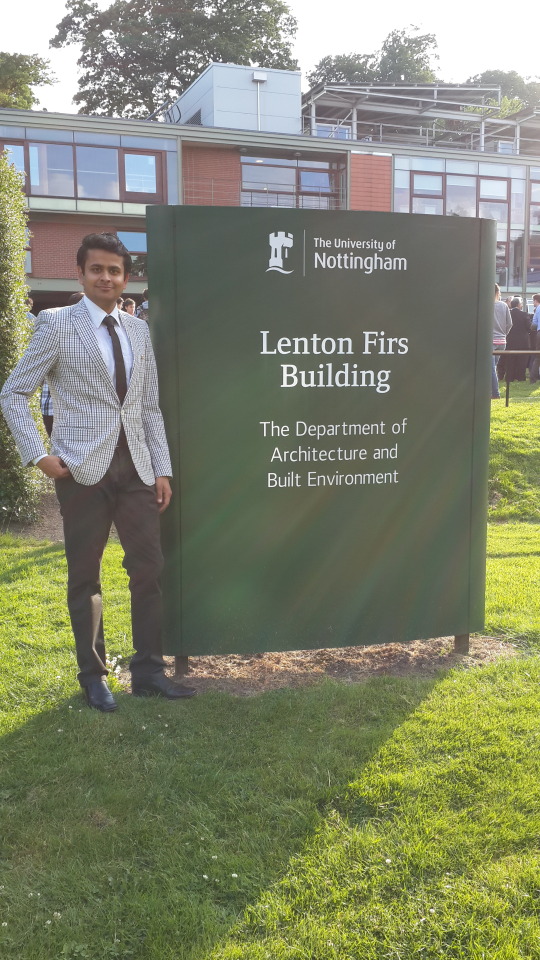
When did you take up Masters?
I took a break for two years after my bachelor’s in India because sometimes the Academic specialisation we aspire to gain does not work in an architectural ecosystem present in our country due to various constraints. Therefore, it was a wise decision to analyse current design trends and the need for specific knowledge required in the domain of current Architecture in India. The break from academics also provided me with some time to travel and reflect on my experience of architecture acquired over the years. During this time, I interned with an architectural firm handling Airport and University designs for Indian government. I was also handling some independent architectural projects to gain insights into the challenges of working as an independent Architect in India. Along with this, I used this time to attend a summer school with Architectural Association London and learned their novel computational techniques for producing new architectural spaces. That was a huge influence on my Masters in Architecture. Due to the reasons stated above, I would recommend all future students to take a break from academics before masters unless you get some exceptional opportunity right after your graduation.
When did you start with the application process considering the time for application, scholarship/bursary deadlines, etc.?
I started the application process around 6 months before. It was a long process because I wanted to apply for scholarship also. I did not want to rush and therefore I arranged recommendation letters, prepared an exclusive portfolio, wrote an essay for the scholarship with much time and attention. It also allows the university to assess your work better if you apply early to these programs.
What preparation did you do before starting Masters?
Getting into a higher university abroad can be pretty daunting. I was paranoid about a lot of stuff related to academics, different culture and place. For academics, I studied the course content beforehand and did some reading to acquire a glimpse of the topics I was about to study. But in Architecture its more about the studio exercises, so I tried to explore how design studios and architectural discourse works in England. Many online resources, student videos, and previous student architectural projects helped me clear out my doubts. Other than this, social media groups from the university, some seniors from the course and university student support prepared me in advance to deal with the cultural shock. The first induction week at Nottingham University was amazing. There were student mentors who showed us around, along with some conferences and lectures about working at Nottingham University. I made some of the best friends that week. I would strongly recommend attending induction week before any masters as it will act as a catalyst to adjust you into a new environment and engrain you into the student fabric of a particular university.
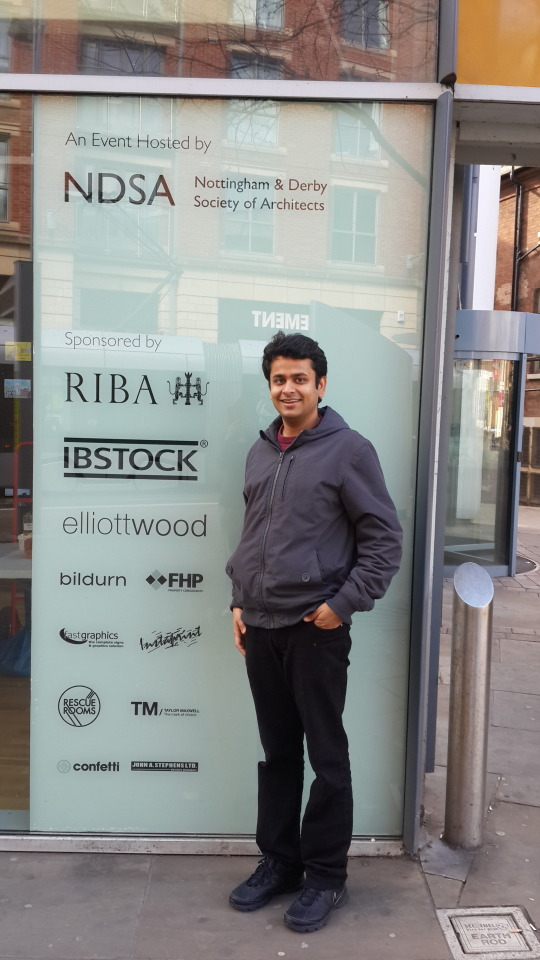
Did you have to give any entrance tests? How did you plan for them?
Yes, I appeared for an IELTS exam scoring a 7.5 to make my visa application stronger. But at Nottingham University I was not required to appear for a Language proficiency test because I scored above 90 per cent Marks in English for my CBSE 12th-grade exam in India.
How long was your program?
Masters in Digital Architecture and tectonics at Nottingham University is an intensive 1-year program including 3 months of dedicated research writing of about 30000 words. This program starts in September every year and finishes after 12 months. After the course duration, University runs student competitions and organise a year-end show that is attended by experts in Architecture from England. This is the best time to showcase your work and catch the eye of an architect aligning your interest. There were not many direct job opportunities through university, but those year-end shows helped me to grab some job offers from current architects who saw my work.
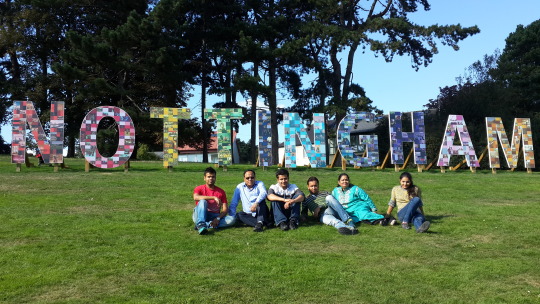
Did you have post-masters plans in mind when you took up masters? Or did you go with the flow?
I was very clear about my future plans after Architectural masters. I wanted to come back to my country after completing my research and contribute to the academic and real architecture domain of the Indian market. India is progressing nation and specific clients and organisations want to experiment and invest in modern architecture. Therefore, I have a keen interest to practise Architecture in India using local resources and my specialised skills.
Did you have to apply for a visa?
My visa process was very smooth. I applied it myself with the help of the Embassy website. All documents required were listed on the website clearly along with the procedure. After my CAS letter the visa process took around a month and I was granted a student visa for a year along with an additional 6 months of post-study work in the UK.
How was the experience at the school?
Architecture department of Nottingham University is a highly respected institution in the UK. It has one of the best research output and infrastructures along with state-of-the-art labs with 3D printing, vacuum forming, CNC machines, Digital 3d scanners and carpentry tools. I had an intensely immersive and international experience at this University. By international I mean there were students from every nationality and they brought in their cultural views into design studios along with expert international mentors. Other than this for the first time in my life I studied architectural research methods, which opened my eyes towards researching in Architectural field in a planned fashion. It was a big surprise for me to learn that there is so much that could be researched and written about Architecture. There was a strong culture of collaboration for inter-departmental research. For example, if we are designing a building façade, we can involve the mechanical department for its physical development and details. That helped us in understanding architecture as a collaborative process, which is vital to practise in the current realm.
Moreover, there was a planned schedule of the program that we followed the whole year. At the start of the course we knew the exact date when we will have our last lecture and submission, a crisp academic plan like that provided us with a clear path of studies. University also provided lectures by an industry leader on current developments in the latest building trends. It provided an exposure that was difficult to gain elsewhere. Along with this, they had field trips which were great in understanding realities of complex forms and their fabrication pedagogy to instil our interest in computational design. Finally, a big opportunity I got was to involve myself in clubs and knowing likeminded people from around the world. I was a member of Architects society, gliding and kayaking club. I used to attend architect socials, fly gliders every month for our training along with kayaking lessons from experts. These clubs helped me to enhance my experience at the university. Overall my experience at school of architecture was very rewarding and fruitful in terms of knowledge and skills I gained during my academic discourse.
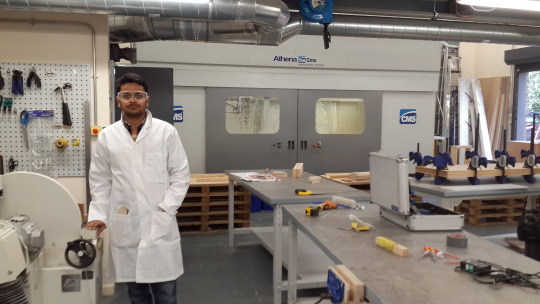
Tell us more about the mentors.
Mentors at Nottingham University are very professional in terms of mentoring students. It was exciting to know about their research and work in the field of architecture. Every mentor was very responsive on emails and I never faced problems meeting with them. They were very supporting and always open for informal discussions too. Some of the professors used to invite students for dinners also at their house. Moreover, Professors always used their industry contacts to introduce us to experts with our research interests.
Eventually, all my professors had an impact on my learning as an architect but few of them motivated me personally. I was very influenced by the work and guidance of Dr John Chilton who is an expert in shell structures and has written many international publications on this subject. Along with this Dr. Paolo Beccarelli who is a leading expert on fabric and tensile structures influenced me to research my master’s dissertation on tensile structures. I was also inspired by the research work and knowledge of Dr Philip Olfield who was the mentor of Tall Buildings studio. He is currently an active member of the Chicago-based Council on Tall Buildings and Urban Habitat (CTBUH). Lastly, I would like to mention my studio mentor Tom Bennett who is an expert in computational design. He was part of the design team for winning proposal of UK pavilion for Milan expo 2015. He was seminal in introducing me to computational design and programming. Currently, he works with a collaborative design practice called Studio Bark in East London.
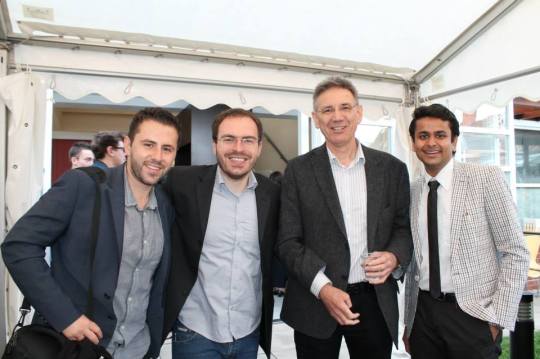
What kind of support system did your institute/university have in place for international students considering a different learning environment from that of Bachelors?
International students at university are supported by the International student office at Nottingham University. They are dedicated to helping you deal with the new environment, emotional concerns along with academic hurdles you face during your studies at the university.
Were you involved in research projects/competitions while studying?
Yes, during our course we participated in national conferences, research projects of our faculty members and architectural design competitions. Along with my Mexican colleague, I won an Architectural award from Benoy Architects London for our project “UK Pavilion- Milan expo 2015”. This project was displayed at the end of the year show along with RIBA exhibition in England.
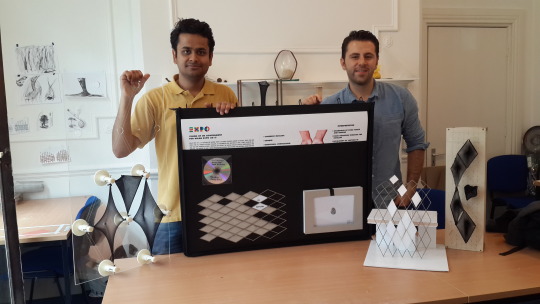
Could you tell us in brief about your dissertation?
My masters concluded with my dissertation research under Dr John Chilton and Dr Paolo Beccarelli. It was titled "INVESTIGATING THE ROLE OF COMPUTER SOFTWARE FOR CONCEPT DESIGN OF TENSILE MEMBRANES IN ARCHITECTURE: A COMPARISON OF PHYSICAL AND DIGITAL MODELLING PROCESS”. This research was awarded merit marks along with appreciation from the industry. Through this research, I investigated how form active structures are being designed using computational power in the current era.
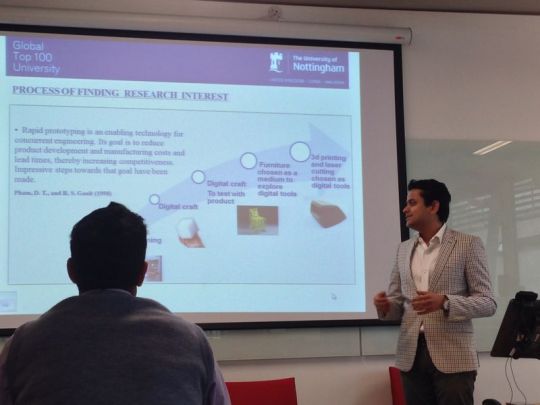
Tell us about the process.
I had a discussion with my supervisor while we were on a field trip to Milan. Our informal discussion helped me understand my topic and methodology that I needed to write a dissertation. Along with formal supervisor meetings, the University of Nottingham organised workshops to demonstrate how to write academic research. These workshops were highly professional and helped me in writing quality research.
We had a clear time table defined from the start of the research. There was a fixed number of times we were supposed to report our progress to the supervisors, but they were always available on mail to answer any queries. My initial meetings with my supervisor were long and intense as they laid the foundation of my research. I used to mail the work before meetings and my supervisor examined and gave his feedback during the office discussions.
There were several challenges during the research. The main challenge was time. In just 4 months we had to write 30000 words for our dissertation. Along with this my first-hand exposure to academic research posed me a problem of setting research goals. It was very tough to organise a vast amount of reading data and experiments into functional research that imparts a meaning to the profession. One of the other challenges was reading, while in India I never read a lot. But during dissertation library was a second home and they had all the academic resources available in the world to support our research material at the Library in Nottingham University.
We had a final presentation before final dissertation writing to include expert feedback into our research. That was followed by intense weeks of writing and submitting our dissertation to the university department as per the deadlines.
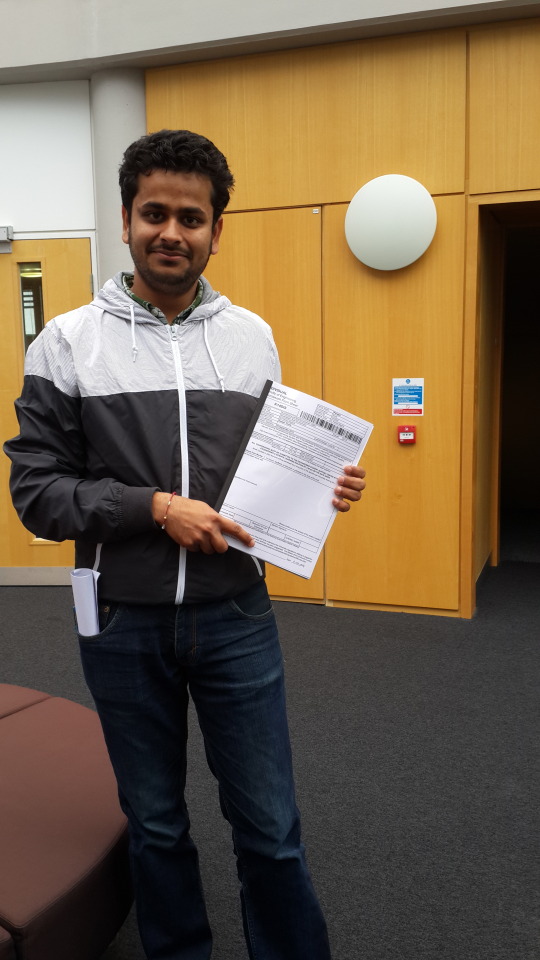
How did you manage the finances?
For my masters, I had a scholarship for 50 per cent of tuition fees. Rest of the expenses of academics and living were covered with the help of my parents. A restricted amount of travelling, self-cooking and budget accommodations were some of the things that helped me to cut down my expenses.
Did you volunteer/work part-time job/intern while studying?
No.
How did you choose your accommodation? Did you have to commute to reach lecture halls?
I took an off-campus accommodation at the university. It allowed me some flexibility in terms of living. It was a large house shared by other students with common amenities. It was nearby university and cheaper than university accommodation.
Did you travel while/after studying?
Yes, during studies, we travelled to many cities as part of architectural field trips in the UK. I covered many British towns along with a Europe trip with international student travel society. All my travel was motivated by curiosity to witness architecture and experience new places. During my travel, I visited some of the architectural marvels in Europe and the UK.
Are there any notable incidents/ anecdotes from post-grad studies that you wish to share?
There are many incidents to share, but one particular I would like to mention. When I started my course at university during initial lectures, I was very participative in studio and interactive with faculty members. So, one evening after my lecture one of my Latin and Chinese friend asked me how come you speak such good English, does India have such a good education in English. I was amazed by the imagery of India in their mind and I laughed and said that in India most of us learn English from kindergarten itself. I told them to read about India and its current development. It is no longer a land of snake charmers only.
How do you think doing a master’s degree helped you?
My master’s degree enriched my career in multiple perspectives. The first and most important thing I gained from my masters was an international exposure in the field of design. It gave me multiple skills to be a part of an international community of design professionals. I presented my designs among a group of international design jurors and participated in design competitions. It gave me courage and confidence as a professional to practise architecture anywhere around the world. Another aspect of international university was learning to work in a team with people from different ideologies and culture. I learned how to embrace these ideas and keep your mind open towards novel thinking, which is vital in the Architectural profession. Due to my masters, I gained the ability to think critically and holistically about architecture. I learned how to discuss and debate ideas academically in intensive studio exercises with experts, how to navigate existing research and most importantly how to research your own ideas using the existing academic resources. At Nottingham university, I was constantly challenged in terms of my ability as an architect and they always guided me professionally to overcome those challenges without spoon feeding. In all, it was worth pursuing masters at the university of Nottingham to explore and equip myself with skills that are helping me in my career as an Architect.
Did the city/country you studied in play a major role during your postgraduate study?
Nottingham as a town is full of history and enriching past in terms of architecture. During my time at Nottingham university, I had a chance to experience this town as a resident. And due to this, I had a significant impact on my design education. I became more sensitive to history, context and climate while designing buildings. Also, public spaces and urban infrastructure is very impressive in England. It gave me an insight into how the quality of urban architecture can influence a citizen’s experience within an urban community. Eventually, I tried to incorporate all these learning into my designs while PG.
Could you please tell us about your current work and future plans?
After returning from the UK my research interest in computational design lead to the creation of an educational blog called PARAMETRIC CURIOSITY. Over the course of years, it has become a community of people from all around the world to witness and talk about computational trends in architecture and design industry. Our current Facebook blog has more than 4600 followers who are engaged in an active community of architects and engineers interested in computational and digital architecture. Eventually, I launched Studio Parametric Curiosity India inspired from my blog’s success, it is an Architectural practice headed by me. We are Involved in developing a sensible urban built fabric by designing multiple architectural projects ranging from residences, commercial, recreational architecture and interiors in Delhi and NCR. Our recent projects include a ceiling Installation in Kenya, a sustainable eco-house in Delhi, a Hotel in Lansdowne along with other building projects. Most of our work stresses upon User functionality, architectural sustainability and integration of computational techniques during the design process.
What message would you like to give to students/professionals planning to take up your program in your school?
For all the prospective students who want to pursue higher education in Architecture, I would like to advise for deep self-introspection for the reason of higher education. Eventually, decide your passion and interest in the current architectural profession to specialise in. Thereafter, find a university that has most research output, facilities and association with experts in the field you want to pursue a master. University is all about soaking the best academics available in the field you want to specialise. One should assess their opportunities carefully and analyse the impact of their education in the future architectural practice.
Looking back, was there anything you would have done differently?
International university education is appealing. New places, people and academic environment all fills you with great spirit and zeal. I would like to warn students to not get carried away from all the new changes that come in your life as a student. Remember your main goal of education and take your academics seriously. All the universities abroad are very serious with quality and timely submission of your assignments along with your performance. Make sure you take full support of university facilities and faculty to get across your academic challenges.
ABOUT THE INTERVIEWEE:
Ar. Gaurav Goel holds a master's degree in architecture from the University of Nottingham, and a master's diploma in parametric design from Spain. He is a gold medallist in B.Arch. from Amity University. Goel founded Parametric Curiosity in 2016, an architecture studio and a social media blog for sharing digital explorations in the field of parametric design. Besides, he has attended many international workshops such as Summer School with Architectural Association - London and Master in Parametric Design at Control Mad - Spain to learn nuances of algorithmic design processes. Goel’s research interests lie in form finding, temporary and permanent pavilion installations, form optimisation, digital fabrication with CNC, 3D printing, architectural façades and other geometrical explorations using computational tools such as Rhinoceros and Grasshopper 3D. His studio's latest projects include a ceiling installation in Kenya, a hotel in Lansdowne, a holiday home in Uttarakhand and a sustainable eco houses in Delhi and Gurgaon.
You can reach him at their Facebook, Instagram and YouTube channel called Parametric Curiosity. For more details about his work and him as a professional visit his LinkedIn account.
#Architecture#architect#architecturestudents#postgraduation#higherstudies#mastersdegree#the united kingdom#nottingham#universityofnottingham#whatafterbarch
0 notes
Photo

Offline Programmer Offline Programmer A CNC Offline is required, for a huge engineering company based in Nottingham. Responsible for Programming new jobs from the drawing and step file, to machine bespoke and small batch parts.
#auto electrical#auto electrician#auto painter#automobile#automotive engineering#car#career#engineering#job vacancies#jobs#mechanical#technician#vacancy
0 notes
Text
CNC Turner train as a Threadwhirler MUST BE APPRENTICE TRAINED
Peterborough, Peterborough, UK Recruiting from Nottingham, Cardiff, London and Milton Keynes A fantastic opportunity is now available to join a leading and global supplier of bespoke food and pet food processing machinery. This family owned business has been established for 100 years and now employs over 300 staff at their manufacturing site where machines are produced from concept to completion all under one roof. My client is now seeking to employ a permanent CNC Turner to be trained up as a Threadwhirler You will be reporting to the Assistant Production Manager - Components Salary: £25,666.92 annual salary pa which equates to £13.2766 an hour. Essential Candidate profile: - Have completed a recognised engineering apprenticeship - Proficient CNC Turner - Able to interpret drawings and specifications - Attention to quality - Flexibility to undertake other tasks in other areas - Flexibility to work nightshift when required - Able to work well within a team environment and to offer improvement ideas - Display a high degree of self motivation - Preferably, already qualified to operate cranes/slings, although training will be provided if necessary. Job purpose: To manufacture, to our drawings, parts that are supplied to our Assembly Shop or direct to customers. Main Duties: - Operate CNC threadwhirlers - Programme CNC threadwhirlers - Self inspection of parts produced - Work to defined schedules - Work to planned times - Be flexible; willing to be multi skilled trained in terms of supporting Operations / turning / grinding - Maintain a safe and tidy environment in the work area, in line with Health & Safety policies and procedures Hours of work: 37 hours/week. Monday to Thursday 7.30 to 16.00 with 30 minute unpaid lunch breaks Friday 7:30 -12:30 Overtime for hours worked over 37/week is paid at time and half. Overtime is not guaranteed. Night shift paid at time and a third Benefits:- Life Assurance: 3x annual salary Holiday: 183 hours (= 24 days) basic entitlement, Holiday year runs from 1 April to 31 March. Entitlement during first year is on a pro-rata basis. In addition the Company gives 3 days between Christmas and New Year, and the normal 8 public holidays. Healthcare: You will be entitled to join the Company's Health Care Scheme, whereby you pay 50% and the Company pays 50% of the cost of Private Health Care cover for you, your partner, and your dependent children, as outlined in the Company's Health Care Scheme document. Pension: Auto-enrolled into pension from first day of employment - minimum of 5%. Company will match your contribution up to 6% - you can put more in than 6% but the Company will only match up to 6%. #weareBRG This vacancy is based in the United Kingdom. Barker Ross Staffing Solutions only operates in the UK and can only process applications from candidates who are currently a resident and eligible to work in the UK. Whilst we endeavour to contact you following your response due to the high volume of applications this cannot always be possible. If you have not had notification within 7 days unfortunately your application has not been successful but we will keep your details on file for future opportunities. This vacancy is being advertised on behalf of Barker Ross Group who is acting as a recruitment agency. from Youth In Jobs https://youthinjobs.co.uk/job/62543/cnc-turner-train-as-a-threadwhirler-must-be-apprentice-trained/
0 notes